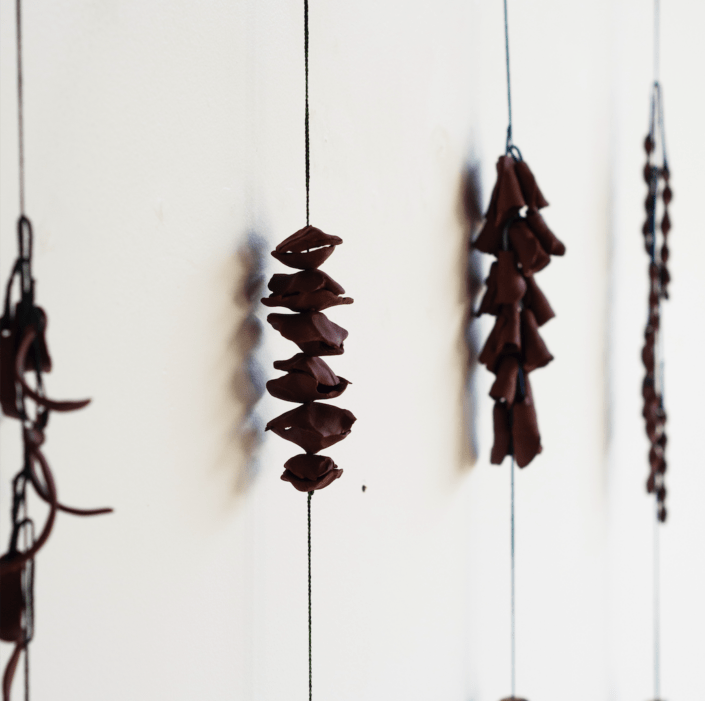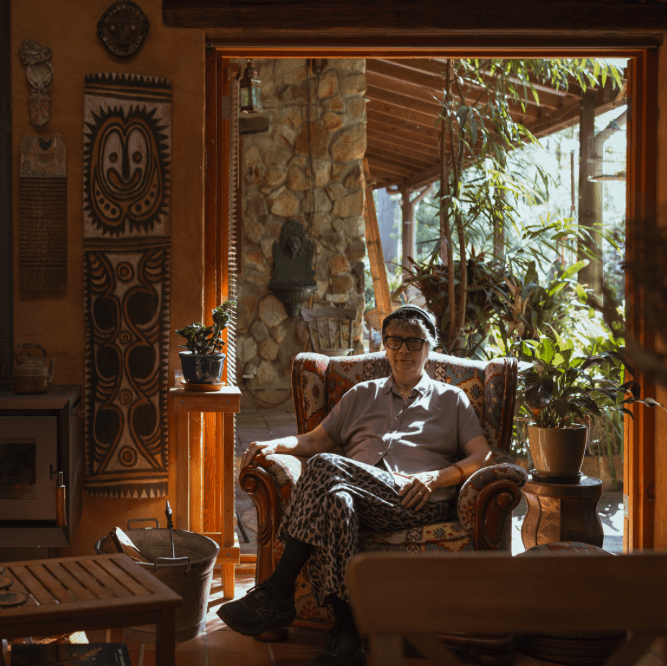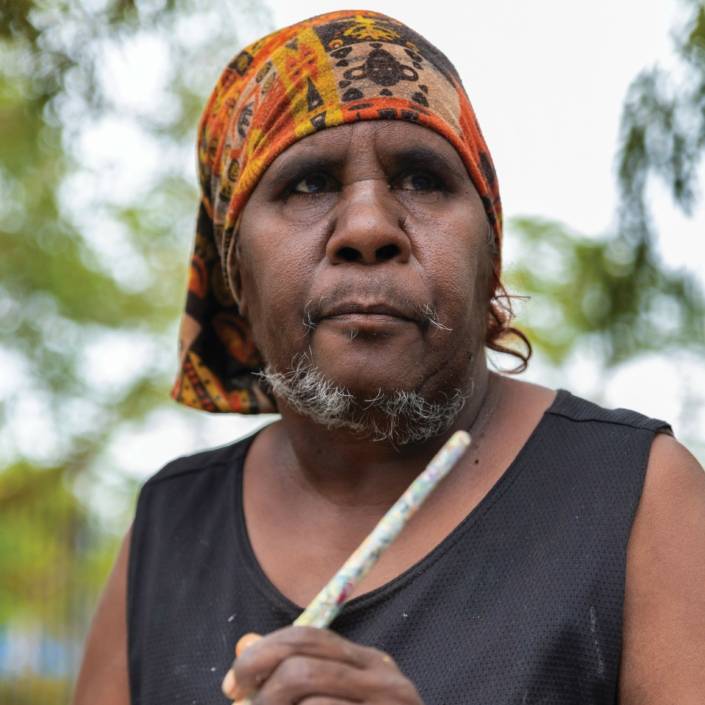Aleks Danko: A Man with a Motto
Aleks Danko has often been described as one of Australia’s seminal conceptual artists but he makes the claim that his work is more a parody of conceptual art than an attempt to be a conceptual artist.
Words: Tracey Clement
Aleks Danko is tricky to pin down. As an artist he defies definition. Danko refuses to commit to any one genre; he is just as likely to be found making drawings and prints as sculptures or installations and his practice also includes performance art. Even his personal identity is complicated. Born in 1950, to Ukrainian refugees, he learned their native tongue long before he ever spoke English and much of his art probes the complexity of
being an Australian while also being “the other”. Danko is known for his way with words. His works frequently incorporate the clever use of language and he writes with confidence and flair, yet despite this fact (or perhaps because of it) his answers to straight-forward questions are more likely to be interesting than direct. Asked what pigeon-hole he would stuff his art practice in, if forced to choose one, he replies, “If you open your mouth too often someone inevitably records what comes out of it and posts it on YouTube or Facebook. So enough of catching flies.”
Throughout his more than four decade long career, Danko has often been described as one of Australia’s seminal conceptual artists. And while he certainly came of artistic age during that moment in the early 1970s, it is a label he has always denied (with uncharacteristic directness). In 1979, when interviewed by James Gleeson he said that his work was a parody of conceptual art, rather than an attempt to be a conceptual artist. In 2013, he still says much the same thing. “Conceptual art was on the whole a very dry affair and my version affords me much more play, silliness, slapstick and stupidity than that other international model…”
In fact, a keen eye for irony, an acerbic wit and wicked sense of humour have been constants in an otherwise incredibly diverse practice. But Danko isn’t just playing for laughs. His work puts Australian culture under the microscope and the results are not always flattering. In his long-term Songs of Australia project that spanned more than a decade, Danko lashed out at xenophobia, racism and nationalism with a series of solo shows with titles such as: VOLUME 8 (we don’t apologise, do we, John?, VOLUME 9 – UH-OH THE CHINESE ARE COMING (take away mix), and VOLUME 16 – SHHH, GO BACK TO SLEEP (an un- Australian dob-in mix).
In his most recent solo show at Sutton Gallery in Melbourne, Danny Storm presents Aleks Danko at The Museum of (con)Temporary Mischief, Danko seemed to turn his critical gaze on the art world. “Danny Storm is a top- shelf kind of guy,” Danko says. “He loves to lubricate and penetrate, and has a particular charm when it comes to using masking tape, polystyrene, and black goo. He is there for me, everyday, as I open the studio door, and turn on the lights, he goes right to work. ‘Alter another ego’ that’s his motto!” As his title suggests, Danko likes to stir things up. Along with his imaginary muse, he exhibited what he calls “pointless portraits” of art stars such as JustCallMeDell The Pineappleman and presented a cast of semi-fictitious guests with cheeky monikers including: Louise de le Prolétariat, Joseph OnlyOneBroom Unkouth, Jenny What’sOn? And Sylvie Furry-Tempting.
At the time of writing, Danko was undertaking an Australia Council residency in Helsinki, Finland. There he continued to channel his own exuberant contradictions. While recent shows such as his DILLY-DALLY SO-SO SHIPPY-SHOPPY? HO-HO HANKY-PANKY? BYEBYE… shopping for and with the un-dead (YU-AH-TISH-YU-AH remix) appeared to be highly critical of the rampant consumerism which is endemic to late capitalism, in Helsinki Danko created site-specific installations in Marimekko stores using their products. But perhaps this isn’t actually such a contradiction. As Danko explains in his unique style, art is just another commodity after all. “DANKO products from the word a-go-go. 1970 and DANKO marketing begins with my first exhibition UCK . More products, more and more marketing …”
Not content with slaughtering the sacred cows of our contemporary culture, Danko even turns his critical humour on himself. In an auto-portrait from 2008-9 (which he says sums up his art practice) he sand blasted the words “It’s such a thin line between clever and stupid” across a bathroom mirror. The piece is “a sort of meet and greet before I (you) begin the day,” Danko says. He is asking us all to take a long hard look at ourselves.
Irene Sutton
DIRECTOR, SUTTON GALLERY
“I have represented Aleks Danko for almost 20 years and continue to be excited by the developments in his practice,” says Irene Sutton. “Over the past decade Aleks has created a body of work which interrogates the social, political and cultural landscape of Australia and beyond, often achieved with a strong measure of satirical humour. His work readily appeals to collector’s that enjoy being stimulated both visually and intellectually. Some private collections of note include the John Kaldor Collection and BHP Billiton, which has a reputation for collecting serious and politically challenging art.”
“Aleks has been repeatedly included in most of Australia’s foremost curated exhibitions and he is represented in depth in every state gallery in Australia, including the National Gallery of Australia, as well as many university and regional galleries,” Sutton says. “QAGOMA recently acquired several of his pieces for their permanent collection.”
“Domestic-scale works are priced between $1,500 and $15,000, whilst a large-scale installation or commission ranges from $30,000 to $77,000,” Sutton explains. “The smaller editioned works, for example some of his mirror text series, “In Your Dreams” and “It’s such a thin line between clever and stupid”, often sell out. People like the ambiguity of his statements.” And once they buy a piece they tend to hang on to it. “You hardly ever see his work on the secondary market,” Sutton admits, “I honestly can’t remember the last time I saw an Aleks Danko at auction.”
Julie Ewington
HEAD OF AUSTRALIAN ART, QUEENSLAND ART GALLERY | GALLERY OF MODERN ART (QAGOMA)
QAGOMA has been collecting Aleks Danko’s work since 1992, but Julie Ewington has been following his career for a lot longer. “What I find interesting about his work I saw around 1971, or 1970, when I first met Aleks when he came over from Adelaide to the Tin Sheds at the University of Sydney,” she says. “There are three things I suppose: the inventive energy (it just never stops), the humour and personal idiosyncratic imagery, and that he ranges so confidently across so many different materials.”
As an artist, Danko seems determined to lampoon our cultural capacity for complacency. “Absolutely,” Ewington agrees. “It’s about being uncomfortable. It’s about unsettling one. He has always been absolutely engaged with social practices and with social settings.” As an example, she cites his Songs of Australia, a project that spanned the Howard years. According to Ewington, “They are very biting, very mordant critiques of nationalism and appeals to nationalism.” Many artists reflect on social issues, but Ewington points out, “What makes him distinctive? The biting humour. The savagery of it. He has that attentiveness to linguistic play that you see a lot with people that have always had two languages. He loves jokes. He has a really black sense of humour.”
More than four decades on, Ewington is still fascinated by the creative output of this significant Australian artist. She describes his career as sustained, inventive and wonderfully unpredictable. As Ewington says, “I’m waiting to see what happens next.”
This article was originally published in Art Collector issue 66, OCT – DEC, 2013.









